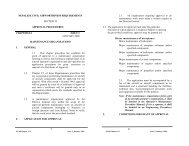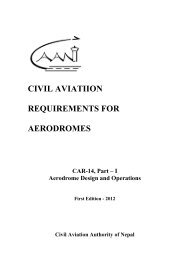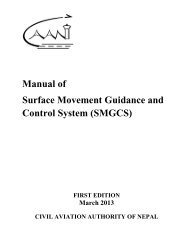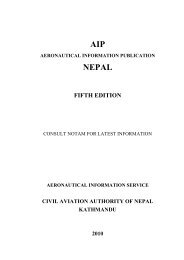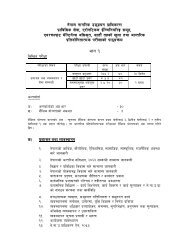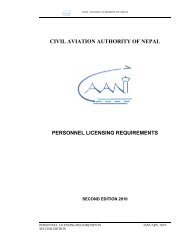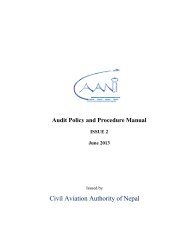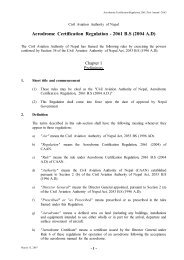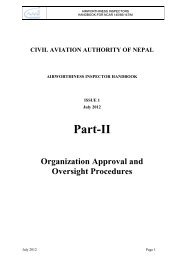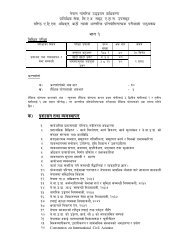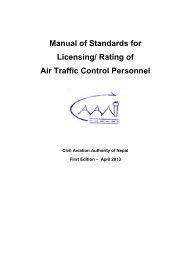CAAN Souvenir 2010.FH10 - Civil Aviation Authority of Nepal
CAAN Souvenir 2010.FH10 - Civil Aviation Authority of Nepal
CAAN Souvenir 2010.FH10 - Civil Aviation Authority of Nepal
- No tags were found...
You also want an ePaper? Increase the reach of your titles
YUMPU automatically turns print PDFs into web optimized ePapers that Google loves.
<strong>CAAN</strong> <strong>Souvenir</strong> 2010IntroductionPerformance-Based Navigation (PBN) is defined asArea Navigation based on performance requirementsfor aircraft operating along an ATS route, on an instrumentapproach procedure or in a designated airspace. It providesa way forward in addressing present and future aviationsystem capacity, efficiency, environmental andsafety issues. PBN is ICAO’s effort and objectiveto redefine the regional differences <strong>of</strong> various AreaNavigation (RNAV) and Required NavigationPerformance (RNP) specifications into a globallyharmonized set <strong>of</strong> PBN applications. The RNAVand RNP components <strong>of</strong> PBN provide a foundationfor evolutionary developments <strong>of</strong> aviation systemsuch as Single European Sky ATM ResearchProgramme (SESAR) and Next Generation AirTransportation System (NextGen).SESAR is a programme launched by EUROCONTROL in2004 to modernize ATM to cope up with the growing demand<strong>of</strong> air travel. The objectives <strong>of</strong> SESAR are to eliminate thefragmented approach to ATM, transform ATM system, andsynchronize the plan and actions <strong>of</strong> different partners andresources. In the past, many initiatives aiming at improvingthe ATM system were undertaken in the European region butfull benefits in most cases were not achieved mainly due tocommitment from stakeholders. SESAR’s core objectives areto develop ATM technology needed to manage increasingdemands with reduced costs and minimum environmentalimpact. Its development phase is between 2008 and 2013with deployment phase from 2014 to 2020.The NextGen Implementation Plan <strong>of</strong> the Federal <strong>Aviation</strong>Administration <strong>of</strong> the United States contains firm, fully-fundedcommitments to new operational capabilities, new airportinfrastructure, and improvements to safety, security, andenvironmental performance. It is a wide ranging transformation<strong>of</strong> the entire national air transportation system in the UnitedStates to meet future demands and avoid gridlock in the skyand at airports. It moves away from ground-based surveillanceand navigation to new and more dynamic satellite-basedsystems and procedures, and introduces new technologicalinnovations in areas such as weather forecast, digitalcommunications and networking. When fully implemented,NextGen will safely allow more aircraft to fly more closelytogether on more direct routes, reducing delays, and providingunprecedented benefits for the environment and the economythrough reductions in carbon emissions, fuel consumption andnoise. Its implementation is aimed for 2025.The ChallengesThe global aviation community is facing significant challenges.As demand for air transportation services increases, Statesare faced with finding solutions to safely increase capacity,efficiency, and access, e.g. to terrain challenged airports.These constraints are largely a result <strong>of</strong> reliance uponconventional ground-based navigation aids (e.g., VOR, NDB,ILS), which limit routes and procedures beyond their coverage.These ground-based systems have served the aviationcommunity well since inception; however, they do not permitKamal P. Rimal*Performance BasedNavigation (PBN) Planningand Implementationthe flexibility available with PBN to meet the presentand future challenges. ICAO has therefore adoptedPBN to address these challenges. Through theapplication <strong>of</strong> Area Navigation (RNAV) andRequired Navigation Performance (RNP)specifications, PBN provides the means for flexibleroutes and terminal procedures. The illustrationsdepict the constraints associated with conventional,ground-based sensor specific routes, proceduresand the flexibilityÊand benefits <strong>of</strong> performancebased,non-sensor specific navigation (both RNAVand RNP).PBN will help the global aviation community to reduce aviationcongestion, conserve fuel, protect the environment, reducethe impact <strong>of</strong> aircraft noise and maintain reliable, all-weatheroperations, even at the most challenging airports. It providesoperators with greater flexibility and better operating returnswhile increasing the safety <strong>of</strong> regional and national airspacesystems.Benefits <strong>of</strong> PBNThe PBN will provide the following benefits.l Environmental Benefitso Reduces emissions by saving fuel. It is expected that 3.15kg <strong>of</strong> CO2 emissions will be eliminated, every 1 kg <strong>of</strong> fuelsavings will be achieved through shorter and verticallyoptimized PBN flight paths. IATA estimates that globally,shorter PBN routes could cut CO2 emissions by 13 milliontones per year. Additionally, PBN provides a mechanismfor optimized pr<strong>of</strong>ile descents that allow aircraft to descendfrom high altitudes to the airport at minimum thrust settings.o Reduces noise pollution. Consistent, precise paths can berouted to avoid noise sensitive areas. Noise levels can<strong>of</strong>ten be reduced through use <strong>of</strong> optimized pr<strong>of</strong>ile descents,which allow lower, quieter thrust levels.l Improve Safetyo Reduces the risk <strong>of</strong> Controlled Flight In to Terrain (CFIT)accidents by providing a very precise lateral and verticalflight path.o Provides consistent, predictable and stabilized approaches.Aircraft arrive at the runway aligned with the centerline,in the same configuration and at the same speed everytime.o Reduces diversions caused by adverse weather conditions,enabling aircraft to reliably access airports with lowervisibility restrictions.l Improve Operating Returnso Reduces fuel waste through shorter flight tracks, optimized1712 th Anniversary Publication



